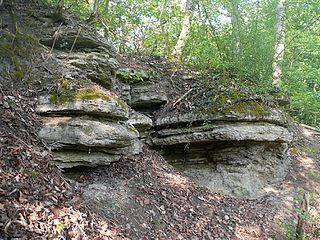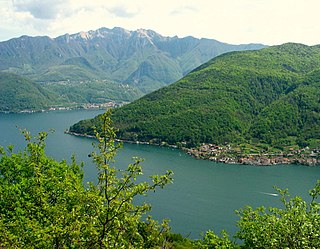Related Research Articles

The Devonian is a geologic period and system of the Paleozoic era during the Phanerozoic eon, spanning 60.3 million years from the end of the preceding Silurian period at 419.2 million years ago (Ma), to the beginning of the succeeding Carboniferous period at 358.9 Ma. It is the fourth period of both the Paleozoic and the Phanerozoic. It is named after Devon, South West England, where rocks from this period were first studied.

The Rhyacian Period is the second geologic period in the Paleoproterozoic Era and lasted from 2300 Mya to 2050 Mya. Instead of being based on stratigraphy, these dates are defined chronometrically.

The Aalenian is a subdivision of the Middle Jurassic Epoch/Series of the geologic timescale that extends from about 174.7 ±0.8 Ma to about 170.9 ±0.8 Ma. It was preceded by the Toarcian and succeeded by the Bajocian.
The Albian is both an age of the geologic timescale and a stage in the stratigraphic column. It is the youngest or uppermost subdivision of the Early/Lower Cretaceous Epoch/Series. Its approximate time range is 113.0 ± 1.0 Ma to 100.5 ± 0.9 Ma. The Albian is preceded by the Aptian and followed by the Cenomanian.

In the geologic timescale, the Anisian is the lower stage or earliest age of the Middle Triassic series or epoch and lasted from 247.2 million years ago until 242 million years ago. The Anisian Age succeeds the Olenekian Age and precedes the Ladinian Age.
In the geologic timescale, the Bajocian is an age and stage in the Middle Jurassic. It lasted from approximately 170.9 ±0.8 Ma to around 168.2 ±1.2 Ma. The Bajocian Age succeeds the Aalenian Age and precedes the Bathonian Age.
The Bashkirian is in the International Commission on Stratigraphy geologic timescale the lowest stage or oldest age of the Pennsylvanian. The Bashkirian age lasted from 323.2 to 315.2 Ma, is preceded by the Serpukhovian and is followed by the Moscovian.
The Campanian is the fifth of six ages of the Late Cretaceous epoch on the geologic timescale of the International Commission on Stratigraphy (ICS). In chronostratigraphy, it is the fifth of six stages in the Upper Cretaceous Series. Campanian spans the time from 83.6 to 72.1 million years ago. It is preceded by the Santonian and it is followed by the Maastrichtian.

The Turonian is, in the ICS' geologic timescale, the second age in the Late Cretaceous Epoch, or a stage in the Upper Cretaceous Series. It spans the time between 93.9 ± 0.8 Ma and 89.8 ± 1 Ma. The Turonian is preceded by the Cenomanian Stage and underlies the Coniacian Stage.
The Santonian is an age in the geologic timescale or a chronostratigraphic stage. It is a subdivision of the Late Cretaceous Epoch or Upper Cretaceous Series. It spans the time between 86.3 ± 0.7 mya and 83.6 ± 0.7 mya. The Santonian is preceded by the Coniacian and is followed by the Campanian.

The Ladinian is a stage and age in the Middle Triassic series or epoch. It spans the time between 242 Ma and ~237 Ma. The Ladinian was preceded by the Anisian and succeeded by the Carnian.

The Frasnian is one of two faunal stages in the Late Devonian Period. It lasted from 382.7 million years ago to 372.2 million years ago. It was preceded by the Givetian Stage and followed by the Famennian Stage.
The Famennian is the later of two faunal stages in the Late Devonian epoch. The most recent estimate for its duration is that it lasted from around 371.1 to 359.3 million years ago. An earlier 2012 estimate, still used by the International Commission on Stratigraphy, is that it lasted from 372.2 million years ago to 358.9 million years ago. It was preceded by the Frasnian stage and followed by the Tournaisian stage.
The Eifelian is the first of two faunal stages in the Middle Devonian Epoch. It lasted from 393.3 ± 1.2 million years ago to 387.7 ± 0.8 million years ago. It was preceded by the Emsian Stage and followed by the Givetian Stage.

The Emsian is one of three faunal stages in the Early Devonian Epoch. It lasted from 407.6 ± 2.6 million years ago to 393.3 ± 1.2 million years ago. It was preceded by the Pragian Stage and followed by the Eifelian Stage. It is named after the Ems river in Germany. The GSSP is located in the Zinzil'ban Gorge in the Kitab State Geological Reserve of Uzbekistan, 35 centimetres (14 in) above the contact with the Madmon Formation.
The Pragian is one of three faunal stages in the Early Devonian Epoch. It lasted from 410.8 ± 2.8 million years ago to 407.6 ± 2.8 million years ago. It was preceded by the Lochkovian Stage and followed by the Emsian Stage. The most important Lagerstätte of the Pragian is Rhynie chert in Scotland. It is named after the city of Prague. The GSSP is located within the Prague Formation at Velká Chuchle, Prague.

In the geological timescale, the Middle Devonian epoch occurred during the Devonian period, after the end of the Emsian age.

The Early Devonian is the first of three epochs comprising the Devonian period, corresponding to the Lower Devonian series. It lasted from 419.2 ± 3.2 to 393.3 ± 1.2 and began with the Lochkovian Stage 419.2 ± 3.2 to 410.8 ± 1.2, which was followed by the Pragian from 410.8 ± 3.2 to 407.6 ± 1.2 and then by the Emsian, which lasted until the Middle Devonian began, 393.3± 1.2 million years ago. During this time, the first ammonoids appeared, descending from bactritoid nautiloids. Ammonoids during this time period were simple and differed little from their nautiloid counterparts. These ammonoids belong to the order Agoniatitida, which in later epochs evolved to new ammonoid orders, for example Goniatitida and Clymeniida. This class of cephalopod molluscs would dominate the marine fauna until the beginning of the Mesozoic Era.
Icriodus is an extinct conodont genus in the family Gnathodontidae.
References
- ↑ Kaufmann, B.; Trapp, E.; Mezger, K. (2004). "The numerical age of the Upper Frasnian (Upper Devonian) Kellwasser horizons: A new U-Pb zircon date from Steinbruch Schmidt(Kellerwald, Germany)". The Journal of Geology. 112 (4): 495–501. Bibcode:2004JG....112..495K. doi:10.1086/421077.
- ↑ Algeo, T. J. (1998). "Terrestrial-marine teleconnections in the Devonian: links between the evolution of land plants, weathering processes, and marine anoxic events". Philosophical Transactions of the Royal Society B: Biological Sciences. 353 (1365): 113–130. doi:10.1098/rstb.1998.0195.
- ↑ Parry, S. F.; Noble, S. R.; Crowley, Q. G.; Wellman, C. H. (2011). "A high-precision U–Pb age constraint on the Rhynie Chert Konservat-Lagerstätte: time scale and other implications". Journal of the Geological Society. 168 (4). London: Geological Society: 863–872. doi:10.1144/0016-76492010-043.
- ↑ "International Chronostratigraphic Chart" (PDF). International Commission on Stratigraphy . September 2023. Retrieved November 10, 2024.
- ↑ Walliser, O.; Bultynck, P.; Weddige, K.; Becker, R.; House, M. (September 1995). "Definition of the Eifelian-Givetian Stage boundary". Episodes. 18 (3): 107–115. doi: 10.18814/epiiugs/1995/v18i3/002 . Retrieved 19 December 2020.
- ↑ Klapper, Gilbert; Feist, Raimund; House, Michael (June 1987). "Decision on the Boundary Stratotype for the Middle/Upper Devonian Series Boundary". Episodes. 10 (2): 97–101. doi: 10.18814/epiiugs/1987/v10i2/004 . Retrieved 19 December 2020.
- ↑ Becker, R.T.; Gradstein, F.M.; Hammer, O. (2012). "Chapter 22 - The Devonian Period". In Gradstein, F.M.; Ogg, J.G.; Schmitz, M.D.; Ogg, G.M. (eds.). The Geologic Timescale 2012. Elsevier. p. 578. doi:10.1016/b978-0-444-59425-9.00022-6. ISBN 978-0-444-59425-9.
- ↑ Préat, Alain; Bultynck, Pierre (2006). "Givetian" (PDF). Geologica Belgica. 9 (1–2): 9–18. Retrieved 12 March 2013.